Layman D. Biology Demystified: A Self-Teaching Guide
Подождите немного. Документ загружается.


Quiz
Refer to the text in this chapter if necessary. A good score is at least 8 correct
answers out of these 10 questions. The answers are listed in the back of this
book.
1. A synapse represents:
(a) A place where the tips of an axon almost touch a muscle fiber
(b) The major central region of a neuron
(c) The fluid-filled gap where two neurons nearly come together
(d) A traveling wave of chemical excitation
2. _____ are masses of epithelial cells specialized for the function of
secretion:
(a) Blood vessels
(b) Hormones
(c) Hormone-binding sites
(d) Glands
3. The mammary (MAH-mair-ee) glands within the female breasts are
most accurately classified as:
(a) Synapses
(b) Chemical messengers
(c) Endocrine glands
(d) Exocrine glands
4. The phrase neuroendocrine system implies that:
(a) Some parts of the nervous system have no relationship to body
secretions
(b) There are just too darn many body structures and functions to
memorize!
(c) Some nervous structures and endocrine gland structures are
functionally related
(d) Certain glands have unknown body functions that the brain can’t
understand
5. Antidiuretic hormone is actually produced and secreted by the:
(a) Posterior pituitary
(b) Anterior pituitary
(c) Entire pituitary body
(d) Hypothalamus
CHAPTER 15 Glands and Messengers 277
[13:26 13/6/03 N:/4058 LAYMAN.751/4058-Alltext.3d] Ref: 4058 Layman: Biology Demystified All-text Page: 277 1-388
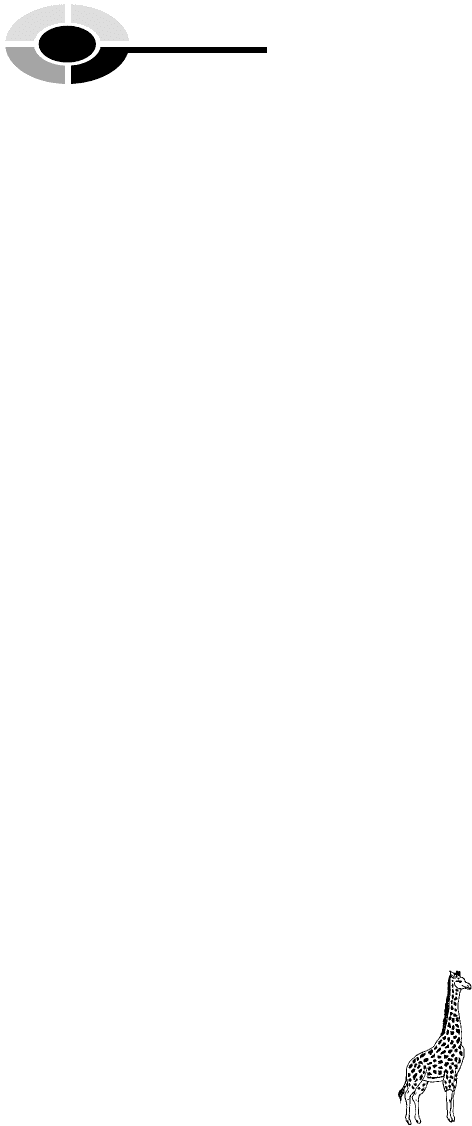
6. TSH exerts a trophic effect upon the _____ gland:
(a) Testis
(b) Thyroid
(c) Thymus
(d) Tonsil
7. Cortisol generally causes the blood glucose concentration to:
(a) Fall towards the lower limit of its normal range
(b) Stay relatively constant at all times
(c) Soar far beyond the upper limit of its normal range
(d) Rise towards the upper limit of its normal range
8. Triggers ovulation (release of a mature ovum):
(a) GH
(b) ACTH
(c) FSH
(d) LH
9. Epinephrine:
(a) Is exactly the same hormone as noradrenaline
(b) Typically causes a profound ‘‘relaxation response’’ and deep sleep
(c) Closely mimics the effects of sympathetic nerve stimulation
(d) Usually decreases the strength and rate of heart contractions
10. A ‘‘Second Messenger’’ is often required in the endocrine system, since:
(a) Most hormones don’t circulate far enough to reach tissue cells
(b) Metabolic action does not respond to hormone concentrations
(c) A lot of hormone molecules are too big to enter their target cells
(d) An error in interpreting the ‘‘First Messenger’’ frequently occurs
The Giraffe ORDER TABLE for Chapter 15
(Key Text Facts About Biological Order Within An Organism)
1. ____________________________________________________________
2. ____________________________________________________________
[13:26 13/6/03 N:/4058 LAYMAN.751/4058-Alltext.3d] Ref: 4058 Layman: Biology Demystified All-text Page: 278 1-388
PART 4 Anatomy and Physiology of Animals
278
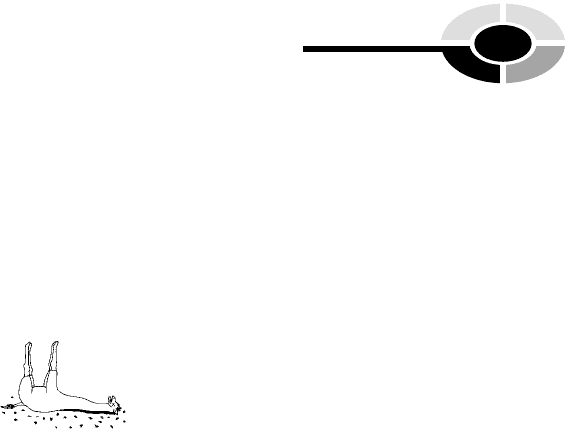
3. ____________________________________________________________
4. ____________________________________________________________
5. ____________________________________________________________
The Dead Giraffe DISORDER TABLE for Chapter 15
(Key Text Facts About Biological Disorder Within An Organism)
1. ____________________________________________________________
2. ____________________________________________________________
3. ____________________________________________________________
CHAPTER 15 Glands and Messengers 279
[13:26 13/6/03 N:/4058 LAYMAN.751/4058-Alltext.3d] Ref: 4058 Layman: Biology Demystified All-text Page: 279 1-388
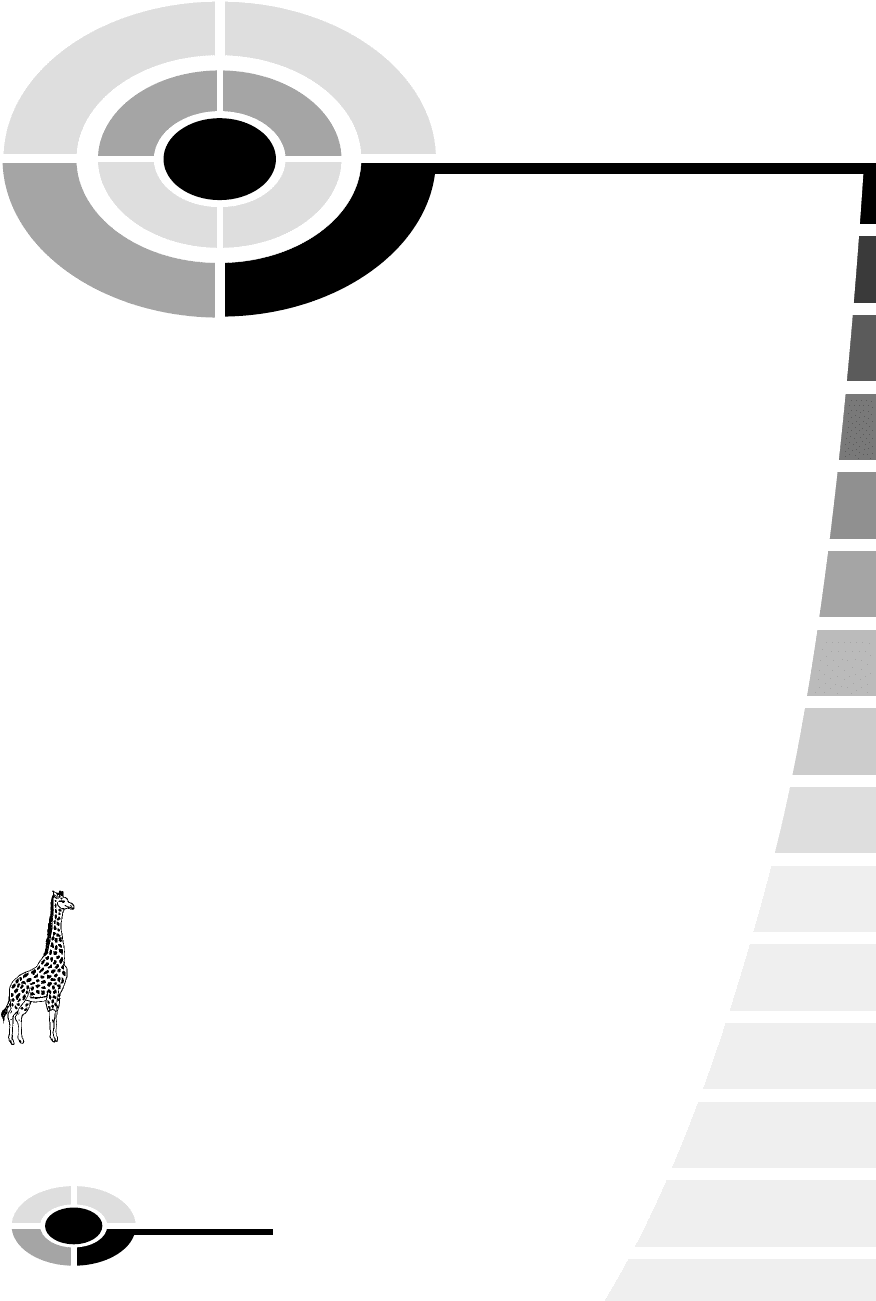
[13:26 13/6/03 N:/4058 LAYMAN.751/4058-Alltext.3d] Ref: 4058 Layman: Biology Demystified All-text Page: 280 1-388
280
CHAPTER
16
Blood and the
Circulatory System
Chapter 15 included an overview of the neuroendocrine system. If you recall,
the endocrine glands (such as the thyroid) all secrete hormones directly into
the bloodstream. But the bloodstream, however, doesn’t carry the blood and
its hormones through the body in a straight line. Rather, it carries the blood
in a ‘‘little circle’’ (circul) (see Figure 16.1).
Chapter 16 thus discusses the circulatory (SIR-kyuh-luh-tor-ee) or cardio-
vascular (car-dee-oh-VAS-kyuh-lar) system. (This was first mentioned in
Chapter 2 and Figure 2.4.) The circulatory (cardiovascular) system is an
organ system including the ‘‘heart’’ (cardi) and ‘‘little vessels’’ (vascul) that
carries the blood in a ‘‘little circle’’ that both begins and ends with the heart.
Along the way, the blood passes by the main body tissues. In so doing, the
blood delivers hormones, glucose, and various other nutrients to the main
body tissues. And, as it leaves, the blood picks up a number of waste pro-
ducts from the main body tissues.
1, Order
Copyright 2003 by The McGraw-Hill Companies, Inc. Click Here for Terms of Use.
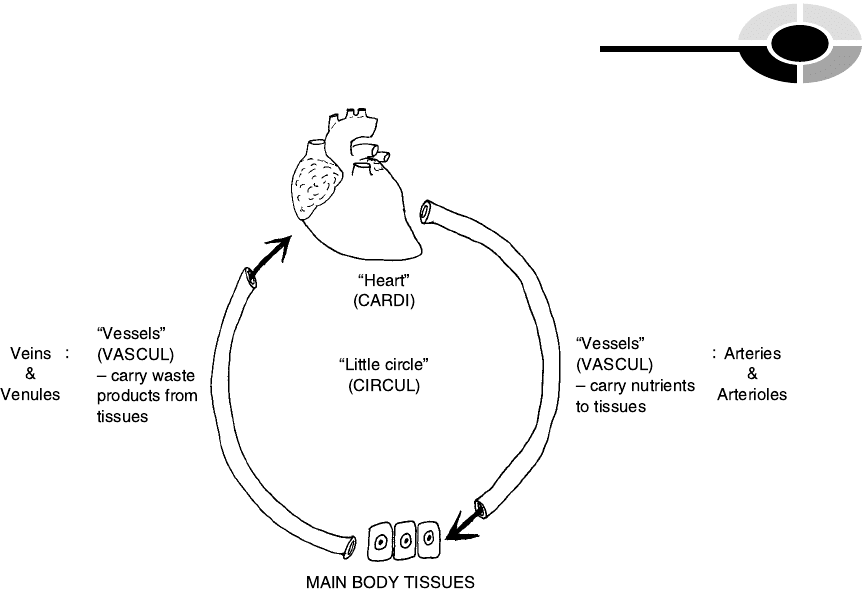
The Heart and Blood Vessels: The Pump and
Its Pipes
Glance back at Figure 16.1. You will see that if the heart represents a pump
for the blood, then the blood vessels represent the pipes carrying it! The
arteries (AR-ter-ees) are large-diameter vessels that always carry blood
away from the heart. Thus, the arteries immediately receive the blood
being pumped from the ventricles (VEN-trih-kls) – the ‘‘little belly’’-like
lower chambers on either side of the heart. Specifically, the right ventricle
(abbreviated as RV) pumps blood out into the common pulmonary (PULL-
mun-air-ee) artery (abbreviated as CPA), which in turn sends blood out
towards both ‘‘lungs’’ (pulmon). And the left ventricle (abbreviated as LV)
pumps blood out into the aortic (ay-OR-tik) arch. The aortic arch sends the
blood from the LV out towards the tissues of the major body systems (other
than the lungs) (See Figure 16.2, A).
As the major arteries (such as the common pulmonary artery and aortic
arch) travel farther from the heart, they branch into smaller arteries
CHAPTER 16 Blood and Circulatory System 281
[13:26 13/6/03 N:/4058 LAYMAN.751/4058-Alltext.3d] Ref: 4058 Layman: Biology Demystified All-text Page: 281 1-388
Fig. 16.1 An outline of the circulatory (cardiovascular) system.

(Figure 16.2, B). And these smaller arteries, in turn, branch into even smaller
arterioles (ar-TEER-ee-ohls) or ‘‘little arteries.’’ As the arterioles approach
the cells of the body tissues, they branch into the smallest blood vessels of all,
the capillaries (CAP-ih-lair-ees). Each capillary is very narrow (much like a
strand of hair). This characteristic is reflected in the translation of capillary,
which ‘‘pertains to a hair.’’
Since the wall of each capillary is only a single cell thick, nutrients and
waste products diffuse across the wall. Nutrients (such as oxygen, O
2
, and
glucose) diffuse out of the bloodstream, and into the tissue cells. And waste
products (such as carbon dioxide, CO
2
) diffuse out of the tissue cells, and into
the bloodstream.
After the capillaries run past the tissue cells, several of them merge
together to form the venules (VEN-yewls). The venules are the ‘‘little
veins,’’ in the sense that they connect the capillaries to the much larger
veins. The veins are all wide-diameter vessels that return blood towards the
heart.
Several of the largest veins return blood back to the atria (AY-tree-ah) –
the small ‘‘entrance rooms’’ (atri) or chambers located at the top of the heart.
Among the biggest sets of veins are the superior and inferior vena (VEE-nah)
cavae (KAY-veye), or ‘‘upper and lower cave veins.’’ The superior vena cava
(SVC) drains blood down into the right atrium (AY-tree-um), or RA, from
the area above the heart, while the inferior vena cava (IVC) returns blood up
into the right atrium from the entire region below the heart.
The four pulmonary veins, as their name suggests, return blood from the
lungs and empty it into the left atrium, LA.
THE SYSTEMIC AND PULMONARY CIRCULATIONS
For ease of study, the major vessels and heart chambers are often grouped
together into two connected circulations. The pulmonary or right-heart cir-
culation involves the circulation of blood to, through, and from the lungs.
The systemic (sis-TEM-ik) or left-heart circulation, in contrast, represents the
circulation of blood to, through, and from the tissues of all the major body
organ systems (except for the lungs). [Study suggestion: Review Figure 16.2.
From this diagram, which specific chamber of the heart begins the pulmonary
circulation? Which specific blood vessels end the pulmonary circulation?
What particular heart chamber begins the systemic circulation? What parti-
cular blood vessels end the systemic circulation?]
[13:26 13/6/03 N:/4058 LAYMAN.751/4058-Alltext.3d] Ref: 4058 Layman: Biology Demystified All-text Page: 282 1-388
PART 4 Anatomy and Physiology of Animals
282
2, Order
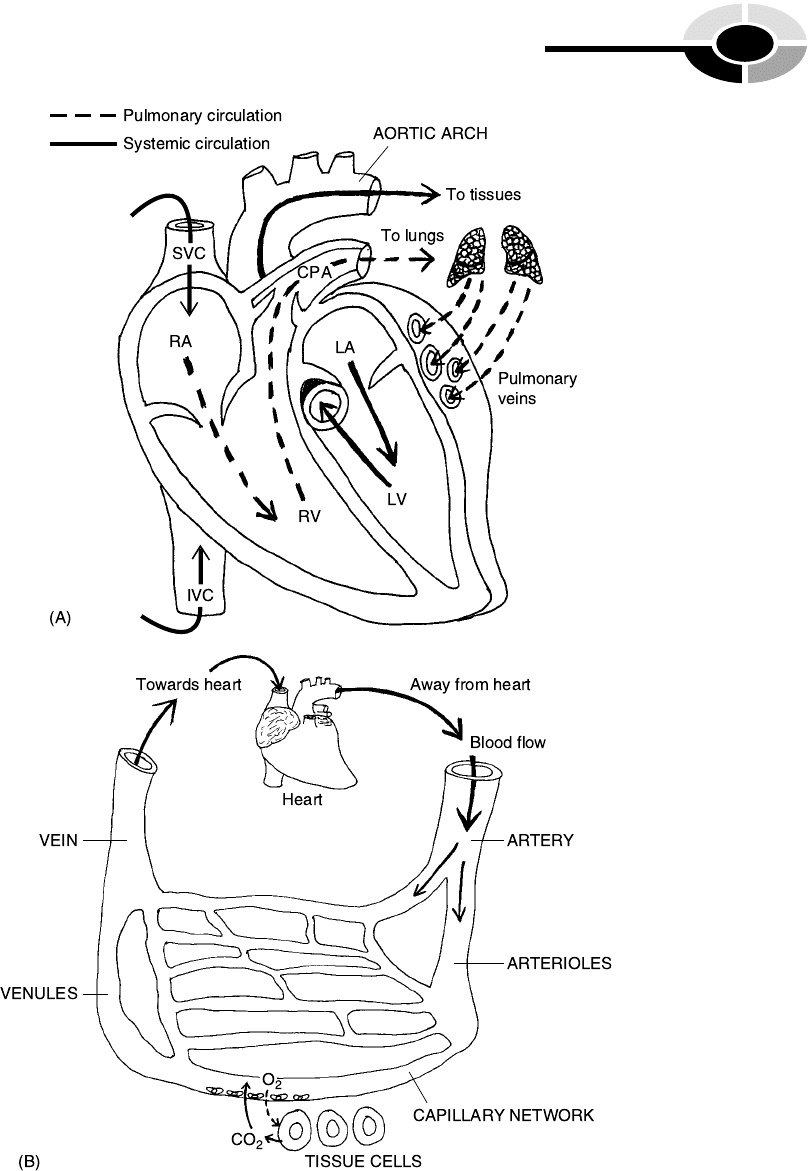
CHAPTER 16 Blood and Circulatory System 283
[13:26 13/6/03 N:/4058 LAYMAN.751/4058-Alltext.3d] Ref: 4058 Layman: Biology Demystified All-text Page: 283 1-388
Fig. 16.2 The major heart pumps and types of blood vessels. (A) The major chambers and
vessels attached to the heart. (B) Smaller blood vessels.
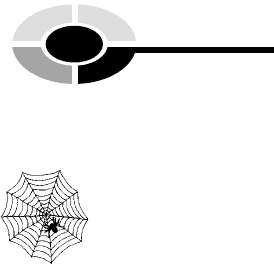
COMPARISON TO CIRCULATIONS IN OTHER VERTEBRATES
The four-chambered human heart (two upper atria, two lower ventricles) plus
a double circulation (pulmonary circulation plus systemic circulation) is pretty
typical of the heart and circulation found in both birds and other mammals.
Being endotherms (or homeotherms) that regulate their own internal body
temperature (Chapter 12), birds and mammals have a great need for energy
and oxygen to keep their body heat always at a fairly high level. A double
circulation plus powerful four-chambered heart provide both the required
force to pump a large volume of heated blood and a separate pulmonary
circulation that adds plenty of oxygen to the blood.
The pulmonary (right-heart) circulation in mammals, therefore, is specia-
lized for adding oxygen to the bloodstream. But the systemic (left-heart)
circulation specializes in extracting oxygen from the bloodstream and deli-
vering it to the tissues of the major organ systems. In the process, carbon
dioxide is picked up from the tissues.
The circulation in vertebrates that are heterotherms (poikilotherms), such
as fish, amphibians, and reptiles, is quite another matter. Fish have a two-
chambered heart with only a single circulation. Amphibians rely upon a
three-chambered heart (two atria, one ventricle) beating within their chests.
Reptiles, likewise, possess a three-chambered heart, with two atria and one
ventricle that is partially subdivided. Both amphibians and reptiles have
double circulations, but there is much less specialization of function of the
two circulations.
Internal Anatomy, Pacemaker Tissue, and
Valves of the Heart
The powerful four-chambered heart of humans and other mammals has a
complex internal anatomy (Figure 16.3). Consider, for example, the myocar-
dium (my-oh-CAR-dee-um) or ‘‘heart’’ (cardi) ‘‘muscle’’ (my). The cardiac
muscle fibers of the myocardium are arranged in a fairly circular pattern
around the heart, so when they contract, they squeeze the blood out of the
heart chambers like a noose tightening around a bag. The blood from the
atria is pushed down into the ventricles, through a pair of one-way valves.
Not surprisingly, these valves are called the right and left atrioventricular (ay-
tree-oh-ven-TRIK-you-lar) valves. These two A-V (atrioventricular) valves
essentially act as one-way doors. They are actually flaps of connective tissue
that are pushed open from above by blood in the atria.
[13:26 13/6/03 N:/4058 LAYMAN.751/4058-Alltext.3d] Ref: 4058 Layman: Biology Demystified All-text Page: 284 1-388
1, Web
PART 4 Anatomy and Physiology of Animals
284

PACEMAKER TISSUE
The atria contract because they are excited by cardiac pacemaker cells. These
pacemaker cells are actually modified cardiac muscle fibers that are self-excit-
ing. Sodium (Na
þ
) and other charged particles are automatically let into the
pacemaker cells at a certain rate or rhythm. This happens because the proteins
in the membranes of the pacemaker cells tend to shift around, allowing ions to
enter and excite the pacemaker cells or ‘‘turn themselves on.’’
The main cardiac pacemaker area is called the sinoatrial (sigh-no-AY-tree-
al) or S-A node (NOAD). This region is called a node because it is somewhat
CHAPTER 16 Blood and Circulatory System 285
[13:26 13/6/03 N:/4058 LAYMAN.751/4058-Alltext.3d] Ref: 4058 Layman: Biology Demystified All-text Page: 285 1-388
Fig. 16.3 Some internal structures and functions of the heart.

[13:26 13/6/03 N:/4058 LAYMAN.751/4058-Alltext.3d] Ref: 4058 Layman: Biology Demystified All-text Page: 286 1-388
PART 4 Anatomy and Physiology of Animals
286
rounded, like a ‘‘knot.’’ The word sinoatrial indicates its anatomical location.
The S-A node lies in the outer wall of the right ‘‘atrium,’’ just below the
entrance of the superior vena cava – a major venous (VEE-nus) sinus (SIGH-
nus). (A sinus, in general, is a large vein that is shaped like a ‘‘hollow bay’’
[sin], holding a considerable volume of blood.)
As the primary cardiac pacemaker, the sinoatrial node excites itself first.
The excitation then spreads from one cardiac muscle fiber to another, due to
the presence of intercalated (in-ter-KAY-lay-ted) discs between them. These
intercalated discs appear as thick dark lines when viewed through a com-
pound microscope. They are actually intercellular bridges ‘‘inserted between’’
(intercalat) adjacent cardiac muscle fibers. Thus, when the S-A node fires off
an action potential, this traveling wave of excitation moves from one cardiac
muscle fiber to another, across the intercalated discs connecting them end-to-
end. Eventually, both atria become excited and contract. And finally, both
ventricles become excited.
SEMILUNAR VALVES
After the ventricles are excited, their walls contract. The blood in the right
ventricle is pushed up into the common pulmonary artery through the right
semilunar (sem-eye-LOO-nar) valve. Likewise, the blood contained within the
left ventricle is pumped up into the aortic arch through the left semilunar
valve. Both of these valves get their names from the shapes of their flaps,
which look like ‘‘partial or half ’’ (semi-) ‘‘moons’’ (lun). This is reflected in
their abbreviation, S-L.
Note back in Figure 16.3 that the myocardium is thicker in the walls of the
ventricles, compared to the atria. And observe that the myocardium is thick-
est of all in the wall of the left ventricle. [Study suggestion: Ask yourself,
‘‘Why is the myocardium thicker in the wall of the left ventricle, compared to
that of the right ventricle?’’ Hint: What happens to a skeletal muscle when
you repeatedly exercise it?]
The Cardiac Cycle
After the chambers of the heart are excited, they go into a state of systole
(SIS-toh-lee) or ‘‘contraction’’ and emptying. It is during systole that the
blood is pumped from each of the ventricles, and out into their major
arteries. After systole, comes diastole (die-AH-stoh-lee) or ‘‘relaxation’’ and
filling. While the atria are still contracting in systole, the ventricles below
